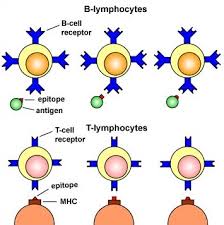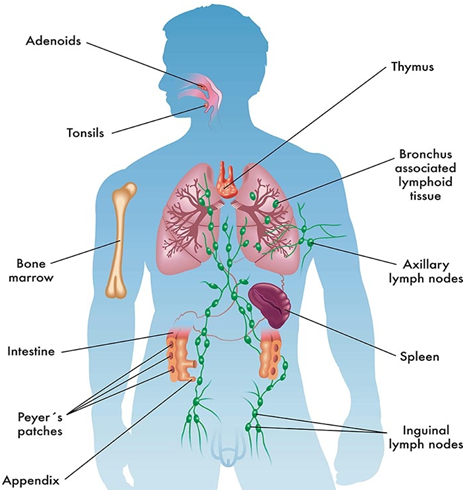Major histocompatibility complex (MHC) moleculesalso known as human leukocyte antigens (HLA) complex are a large set of cell surface protein molecules that are controlled by a collection of polymorphic genes known as the major histocompatibility complex (MHC) which are located on chromosome 6 in humans and on chromosome 17 in mice. The MHC is a set of gene family that encodes the production of MHC molecules; and theyhelpthe immune system to discriminate between self and non-self-molecules.MHC molecules are the main inducers of cell-mediated immunity i.e. T cell immune response; and they also take part in humoral immune response.
The T cells unlike B lymphocytes cannot recognize antigens on their own except those antigens that have been presented by MHC molecules or are complexed with the MHC molecules. The major biological function of the MHC molecules in immune response is to signal to the T cells that a particular cell is infected; and this signal stimulate the cell-mediated immune response which is mainly dominated or controlled by T cells inclusive of T helper (TH) cells and T cytotoxic (TC) cells. Thus MHC molecules act as antigen presenting cells (APCs) since they help the T cells to recognize antigens.
MHC molecules are clinically significant because they can trigger T cell immune response in individuals receiving transplanted tissues or organs; and such reaction can lead to the rejection of the grafted organ or tissue since MHC molecules are present on the plasma membrane of virtually all human tissue cells and they are unique for each individual except for closely related individuals (e.g. identical twins). The MHC/HLA molecules serve as a unique biomarker of individual identity.
They are applied in a series of biomedical and medical applications in which HLA typing is used to determine paternity and also to determine HLA compatibility between donor and recipient hosts prior to transplantation or grafting. It is worthy of note that the MHC (HLA) molecules where discovered from the notable works of George D. Snell and Peter A. Gorer in the early 1930s who both investigated tissue transplantation in inbred mice. The major histocompatibility (MHC) molecules or HLA plays critical role in immune response (inclusive of cell-mediated and humoral or antibody-mediated immune response).
Most microbial infections or diseases are caused by intracellular microbes (e.g. viruses, protozoa and bacteria) that are well-known for living inside the cells of their host where antibodies and other components of the immune system cannot easily reach them. Since the surfaces of host cells are lined with unique MHC/HLA molecules which help to distinguish self-molecules from non-self-molecules; the MHC molecules recognizes and binds to peptide molecules released by the intracellular parasites and thus displays these peptide molecules to the T cell component of the immune system which identifies and kill the invading pathogen. MHC molecules generally enable T cells to recognize and bind antigenic peptides that emanate from intracellular microorganisms; and they also play critical roles in immune recognition and discrimination. There are three main variants of the MHC/HLA molecules.
CLASS I MHC MOLECULES
Class I MHC molecules present peptide molecules from intracellular antigens (or pathogens) to T cytotoxic (TC) cells otherwise known as CD8+ cells. They are found on the surface of virtually all nucleated cells of the human body; and Class I MHC molecules are the most important HLA molecules recognized by recipient host cells during grafting or transplantation. Thus class I MHC molecules are able to stimulate immune response in recipient host receiving graft tissues or organs especially those with a different class I MHC molecules. This is the basis for HLA typing in clinical medicine in order to determine MHC compatibility between donor and recipient hosts prior to transplantation. Class I MHC molecules are principal in the lysis of virus infected cells; and their presentation of proteolytically degraded protein molecules from intracellular pathogens to TC cells (CD8+ cells)facilitate the initiation of cell-mediated immune response.
CLASS II MHC MOLECULES
Class II MHC molecules present peptide molecules from antigens or pathogens to T helper (TH) cells also known as CD4+ cells. They are mainly found on the surfaces of immunocompetent cells especially antigen presenting cells (e.g. macrophages, langerhans cells, B cells and dendritic cells). While class I MHC molecules present endogenously processed or synthesized peptide molecules to TC cells, class II MHC molecules only present exogenously processed peptide molecules internalized by APCs (e.g. macrophages). This implies that Class I MHC molecules only recognizes and present endogenously synthesized antigens or pathogens (e.g. viral particles and other intracellularly-placed pathogens such as Rickettsia and Chlamydia species) while Class II MHC molecules only recognizes and present the antigens of extracellular pathogenic microorganisms that have been engulfed by phagocytes. Such extracellular pathogenic microorganisms include bacteria and other microbial proteins that are usually degraded exogenously.
CLASS III MHC MOLECULES
Class III MHC molecules are a group of free unrelated protein molecules which unlike class I and class II MHC molecules do not take part in the presentation of peptide molecules from antigens to T cells. They primarily take part in other immune system functions (e.g. the initiation of the complement system, heat shock proteins (HSPs) and inflammatory reactions). Class III MHC molecules do not share structural similarity with either class I or class II MHC molecules.
The ability of T helper cells or CD4+ cells to recognize only peptide molecules complexed with class II MHC molecules and for T cytotoxic cells or CD8+ cells to recognize only peptide molecules complexed with class I MHC molecules is because the MHC/HLA molecules exhibit major histocompatibility complex (MHC) restriction. MHC restriction is simply defined as the ability of the T cells (i.e. CD4+ and CD8+ cells) to specifically recognize antigenic peptide molecules presented by the right type of MHC molecules either Class I or Class II molecules.
This class restriction exhibited by the MHC molecules is controlled by specific genes or binding sites found on the T cell receptors (TCRs); and these binding sites are unique for both CD4+ cells CD8+ cells thus the reason why they only recognize antigenic peptide molecules presented by Class II and Class I and Class I MHC molecules respectively. TCRs generally recognize only antigens being presented by MHC molecules.
And just like B cells differentiating and proliferating into antibody-secreting plasma cells and memory B cells after encountering an antigen; T cells also become activated, differentiate and proliferate into other effector T cells and memory T cells after encountering an antigen on its receptor (i.e. TCRs) through the assistance of the MHC molecules. T cells only bind to antigens complexed with any of the MHC molecules while B cells are capable of binding to soluble antigenic molecules without the help of the MHC molecules. And this is the basic difference between the cell-mediated immune response and the humoral or antibody-mediated immune response.
REFERENCES
Abbas A.K, Lichtman A.H and Pillai S (2010). Cellular and Molecular Immunology. Sixth edition. Saunders Elsevier Inc, USA.
Actor J (2014). Introductory Immunology. First edition. Academic Press, USA.
Alberts B, Bray D, Johnson A, Lewis J, Raff M, Roberts K and Walter P (1998). Essential Cell Biology: An Introduction to the Molecular Biology of the Cell. Third edition. Garland Publishing Inc., New York.
Bach F and Sachs D (1987). Transplantation immunology. N. Engl. J. Med. 317(8):402-409.
Barrett J.T (1998). Microbiology and Immunology Concepts. Philadelphia, PA: Lippincott-Raven Publishers. USA.
Jaypal V (2007). Fundamentals of Medical Immunology. First edition. Jaypee Brothers Medical Publishers (P) Ltd, New Delhi, India.
John T.J and Samuel R (2000). Herd Immunity and Herd Effect: New Insights and Definitions. European Journal of Epidemiology, 16:601-606.
Levinson W (2010). Review of Medical Microbiology and Immunology. Twelfth edition. The McGraw-Hill Companies, USA.
Roitt I, Brostoff J and Male D (2001). Immunology. Sixth edition. Harcourt Publishers Limited, Spain.
Zon LI (1995). Developmental biology of hematopoiesis. Blood, 86(8): 2876–91.
Discover more from #1 Microbiology Resource Hub
Subscribe to get the latest posts to your email.



